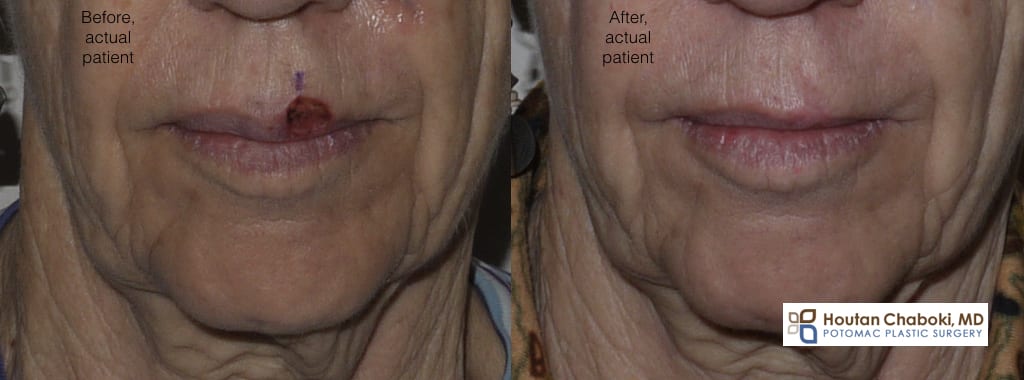Ready for summer? Now is a good time to remember to protect your skin before heading to the beach. These health maintenance and skin cancer prevention tips are really for the entire year, but more important during high sun exposure periods.
Skin cancer is the most common form of cancer in the US, and one of the cancers that can be prevented with a healthy lifestyle. Many skin cancers don’t just occur in the elderly, but rather in young adults due to prolonged UV radiation exposure. Sunburns and tanning beds are just terrible for the skin! Being the most exposed to the sun, the nose and face are the most likely to develop skin cancer.
Fortunately, the most common forms of skin cancer, basal cell carcinoma and squamous cell carcinoma, are also the most curable when detected early. Treatment is primarily with surgical excision and MOHS surgery. However, melanoma is another type of skin cancer that can spread to other body parts and be fatal.

Before and after photograph of skin cancer surgery of the upper lip. MOHS surgery required removal of the cutaneous white lip, lip line, red lip, and muscle to remove the cancer. Reconstructive plastic surgery helped restore lip shape and function. Further lip enhancement could be achieved with injections of facial filler (ex. Juvederm) or fat to add volume.
Check your skin
Perform skin exams yourself and monitor new skin lesions or changes to existing areas. Contact your physician if you notice any ABCDE signs of a mole, which could indicate a skin cancer:
- Asymmetry – mole is not symmetric in shape or texture
- Border – irregular edges
- Color – different colors
- Diameter – larger than a pencil eraser
- Evolving – moles that change in size, shape, or color
Based on clinical examination and history, a physician might be able to provide a professional diagnosis on a mole or skin lesion. However, a skin biopsy sent to a laboratory may be required to determine if a skin lesion is benign or a skin cancer.
Schedule an exam
Visit your primary care physician, dermatologist, or plastic surgeon for a professional skin exam. Patients who have had prior abnormal biopsies or risk factors for skin cancer should check with their physician more frequently.
Use sunblock all year
Sunblock should be used routinely throughout the year, not just for trips to the beach. A majority of the sun’s rays can still penetrate your skin even on cloudy days. In addition, water, snow, and sand can reflect harmful rays back to your skin, increasing skin cancer risk.
The best sunblocks are SPF 30 or higher, broad spectrum protection against UVA and UVB rays, and water resistant. All sunblocks must be reapplied after every few hours or whenever you get wet.
Practice sun protective lifestyle
If possible, avoid being outside when the sun is the strongest, usually between 10am and 4pm. Try to minimize your time outside during this timeframe.
Sun protective clothing, such as long-sleeve shirts, pants, and wide-brimmed hats, helps protect against ultraviolet rays. An umbrella is another great idea on sunny days.
Avoid tanning
Lose the tan. Never use tanning beds and avoid sunbathing.
Have other methods or tips to help prevent skin cancer? There is evidence that caffeine consumption (coffee or tea) can also help reduce risk of skin cancer. Share your thoughts below.


Leave a Reply